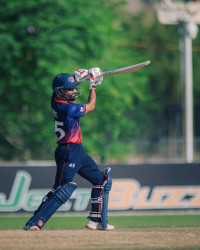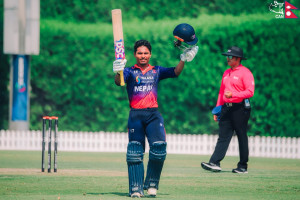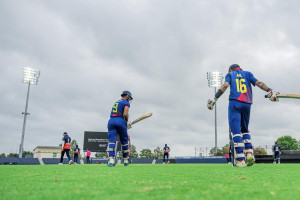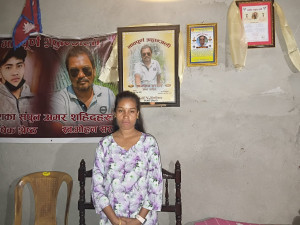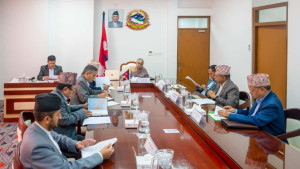Cricket
Three things to learn from Nepal’s performance in Top End T20 Series
Here, the Post takes a look at three things we learned from Nepal’s performance in the fourth edition of the Top End T20 Series.
Nayak Paudel
Nepal got knocked out of the Top End T20 Series after losing their final league-stage game against Pakistan Shaheens by one run at DXC Arena in Darwin, Australia, on Friday.
Nepal, who were invited to field first, restricted Pakistan to their second-lowest total of the tournament: 144/9. Pakistan batted first in five of their six league-stage games, with their lowest total being 111 runs against Perth Scorchers Academy on August 16. Their highest total was 227/4 against Bangladesh ‘A’ in the tournament opener on August 14.
The Rhinos were in the chase until the penultimate delivery. They needed eight runs to win in the last over, but they could only manage six runs and ended the second inning at 143/7.
With the loss, Nepal’s chance for a spot in the semi-final stage has ended. Nepal lost four of their six games in the series and could add only four points from the two wins.
Here, the Post takes a look at three things we learned from Nepal’s performance in the fourth edition of the Top End T20 Series:
Longer boundaries and catchouts
The Rhinos had a poor start to the tournament, having lost three consecutive games, all while bowling first.
In the 135/8 score while chasing 178 against the hosts—Northern Territory Strike—five of the Nepali batters were caught out at DXC Arena. Of them, Lokesh Bam was caught inside the circle while Aasif Sheikh, Rohit Kumar Paudel, Kushal Malla and Dipendra Singh Airee were caught outside.
Five Nepali batters also returned to the pavilion after getting caught out against Bangladesh ‘A’ while chasing 187 runs at the same venue. Aasif was caught behind while Kushal Bhurtel, Lokesh Bam, Paudel and Malla were caught inside the circle.
In 144/7 while chasing Melbourne Stars Academy’s target of 175/7 at TIO Stadium, Nepal lost two wickets to catches. Paudel and Malla were caught inside the circle and near the boundary line, respectively.
Nepal won their first game in the series, defeating Hobart Hurricanes Academy by 66 runs at Cazalys Arena on August 19. Nepal posted 180/7 while batting first for the first time and bundled the Hurricanes at 114 runs in 16.1 overs.
Nonetheless, Nepal had lost five wickets against the Hurricanes to catchouts. Bhurtel was caught behind while Aarif Sheikh was caught inside the circle. Aasif, Malla and Karan KC were caught near the boundary rope.
The visitors also suffered four catchouts against Melbourne Renegades Academy on August 20 while posting a total of 139/9 at Cazalys Arena. Nepal won the match by 33 runs but were again troubled by catches.
Four Nepali batters were caught out—Aarif and Airee inside the circle and Aasif and Bam near the boundary—against the Renegades.
In the match against Pakistan on Friday, Nepal lost Bhurtel, Paudel and Bam to catchouts. Paudel, who had just crossed the half-century mark, was caught inside the circle while playing an unorthodox shot while Bhurtel and Bam were victims outside the circle.
DXC Arena’s square boundary is 73 metres while the straight boundary’s length is 86 metres, states PerfectLineup, an online site focusing on analysis of different sports, including cricket.
“The boundary of TU Cricket Ground, at the most, is 65 metres while a square boundary can reach up to 75 metres max when played in the furthest pitch,” said Durga Nath Subedi, an ICC-recognised umpire of Nepal. “Many players, including those termed as hard-hitters of Nepal, were seen getting dismissed in Darwin while trying to hit long in bigger boundaries than they are used to.”
Nepali batters could muster 16 sixes and 67 fours in six games. The bowlers conceded 19 sixes.
Difference in abilities and playing conditions
Except for Sandeep Lamichhane, who has been part of Australia’s Big Bash League in four seasons, Nepali players had not played in the Aussie conditions.
Weather-wise, Darwin is hotter than Nepal, making the pitch conditions different from what the Rhinos are used to playing on.
The first win, coming in the fourth match after three consecutive losses, also suggests that Nepal needed time to get used to the climate and conditions of the Northern Territory.
Further, Nepal faced ‘A’ teams of two Test nations—Bangladesh and Pakistan. The Rhinos have always struggled against the experience of Test-playing countries despite showing hopes for a win at different stages of the match.
Similarly, Nepal’s senior national side was not on par with the academy teams of the BBL franchises. The gap suggests that Nepali cricket is still far from challenging the national teams of the cricket heavyweights.
Challenge for spots in Playing XI
Bhurtel and Malla were the only two players of the 16-member squad that head coach Stuart Law took to Australia to play all six games. Otherwise, there were several changes in every game.
The changes were also a result of Law wanting to analyse his players properly at a time when Nepal are getting ready for big matches. Nepal are playing the West Indies in a three-match T20I series at September-end in Sharjah, the UAE.
After that, Nepali cricketers will travel to Oman in October for the regional qualifiers for the 2026 T20 World Cup.
Law will be looking for his best players for the two high-stakes tournaments.
The regular changes to the playing set keep the players under pressure to perform well consistently. The move will lead players to improve themselves every day and prove their worth in every game.
Possibly, the playing set against Pakistan Shaheens on Friday was Law’s best based on the performances in the series. Still, there are many more players back home waiting for their chance to sign and ensure a spot in Law’s squad.
Nonetheless, Law and his players are not returning anytime soon despite getting knocked out of the series. It is because they are playing five more friendlies on Australian soil.
The Rhinos will play the Australian Capital Territory (ACT) on August 26 and the South Australia Cricket Team (SACT) on August 28. Further, Nepal will play ACT and SACT in two T20s, one after another, the same day.
The Rhinos will end their stay in Australia with a one-day fixture against SACT on August 30. Leaving the Northern Territory and travelling to the central and southern regions for more games will help Nepali players get used to new conditions and new challenges.




 18.12°C Kathmandu
18.12°C Kathmandu




